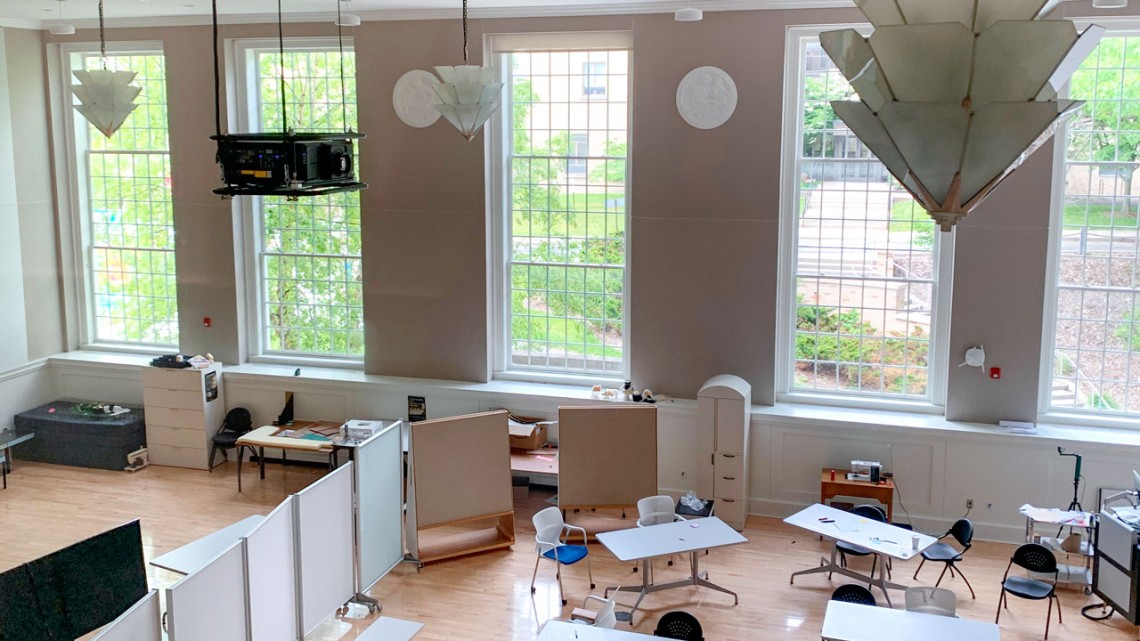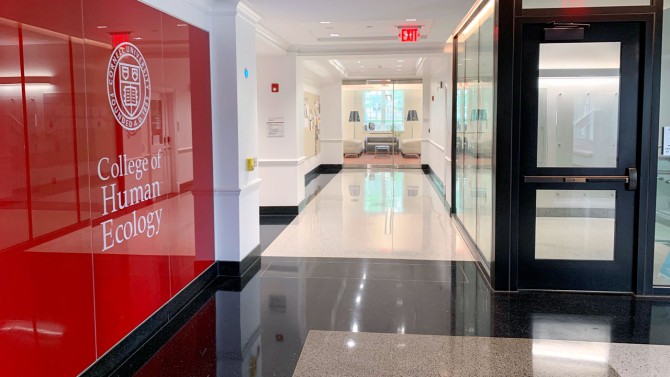
In the Martha Van Rensselaer auditorium, the original Art Deco chandeliers were restored and rehung, and original architectural detail retained, while the room was equipped for adaptability with hybrid teaching technology.
From lighting to furnishings, MVR credited for inclusive design
By James Dean, Cornell Chronicle
In a once dimly lit corridor stretching across Martha Van Rensselaer Hall, daylight now floods through windows over red- and pink-cushioned benches, filtering into offices bordered with translucent glass.
Dark terrazzo flooring gives way to lighter blocks at key destinations inside the College of Human Ecology (CHE) and the Cornell Jeb E. Brooks School of Public Policy, where overhead lighting also intensifies to subtly help visitors find their way.
And in a circular stair tower, a hanging sculpture of steel rods and shimmering dichroic film creates an inviting passage, while common areas furnished with artistic chairs and tables encourage students, faculty and staff to rest, collaborate or engage with pieces relevant to design studies.
After more than 15 years of renovations, those are some of the touches that have earned MVR a “first” among Cornell facilities: In winning LEED Gold certification, it received a credit for inclusive design aimed at supporting occupants’ physical and emotional well-being.
“Inclusive design means being aware of and embracing the wide range of users within a space and making every design decision with human diversity in mind,” said Joanna Luh ’20, who was instrumental in pursuing the credit as a student intern. “Prioritizing inclusivity in design is essential in the creation of environments that are welcoming and that encourage the users to thrive no matter who they are. The MVR renovation did just that.”
On June 10 at 1:30 p.m., CHE will host a pandemic-delayed rededication and ribbon-cutting ceremony celebrating the completion in 2020 of three phases of renovations, each of which was certified LEED Gold under the U.S. Green Building Council’s Leadership in Energy and Environmental Design rating system.
Guests are expected to include President Martha E. Pollack and other senior administrators, current and former CHE deans, and representatives from the State University of New York Construction Fund, which since 2004 has invested more than $100 million in renewal of the now 90-year-old building.
Following the ceremony, participants may take a self-guided tour through 10 points of interest – from the MVR Auditorium’s restored art deco chandeliers to the Commons linking MVR and the Human Ecology Building, where cloud-like mesh light fixtures are examples of “biophilic elements” designed to incorporate or reflect nature.
Part of LEED’s “innovation in design” category, the pilot credit for inclusive design applies to the renovations’ third phase, but the concepts were baked into the entire project, said Matthew Kozlowski, environmental and energy services section manager in Facilities and Campus Services.
“It’s just good design,” Kozlowski said. “This is a great template for other projects.”
The credit was achieved thanks in large part to documentation Luh produced under the guidance of Kozlowski and Kristine Mahoney, director of facilities and operations at CHE and the Cornell Brooks School, which cataloged inclusive features and created training materials.
In addition to flooring and lighting details that support wayfinding, Luh noted signage that includes text, graphics and Braille. Classrooms and offices provide adjustable furnishings and assistive technology, going beyond minimum accessibility requirements. Doors use lever handles and push bars instead of knobs that require twisting movements. Textured panels and wallpaper create a more stimulating and dynamic experience than plain walls.
In the repositioned first-floor corridor, windows previously blocked by offices now provide views and harvest light that the offices “borrow.” Access to natural light and connections to nature are known to benefit workers’ mental health and productivity, Mahoney said.
Strategies including extensive reuse of office furniture saved money for acquiring the more iconic design items. CHE also said the renovations diverted more than 1,000 tons of waste from landfills, while more than a third of new materials were made with recycled content.
“It’s about choices and effort more than cost,” Mahoney said of the college’s commitment to inclusive design, consistent with its mission.
Luh, now a Boston-based interior designer, said the project helped shape her perspective on what constitutes thoughtful, high-quality and forward-thinking design in her career.
“In summary,” Luh wrote in the LEED application, “the MVR project has a strong focus on inspiring, encouraging and supporting the mental and emotional health of its occupants.”
Media Contact
Get Cornell news delivered right to your inbox.
Subscribe

